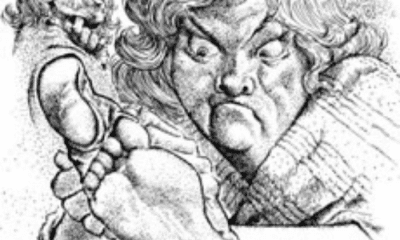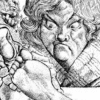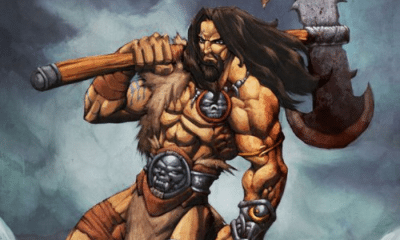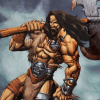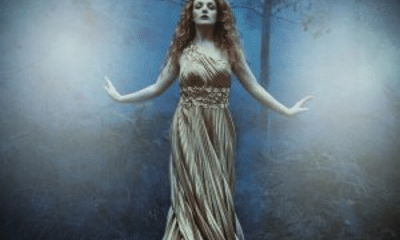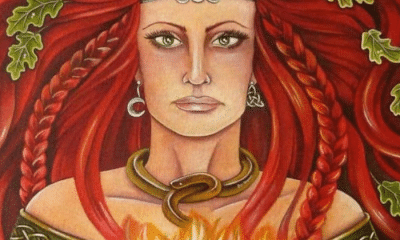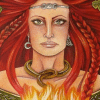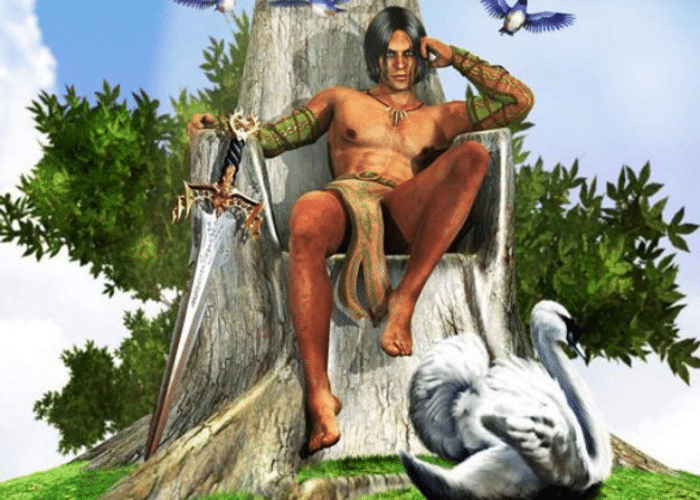
Irish
Aengus: The Irish God of Youth
Aengus: The Irish God of Youth
Aengus was one of the most popular heroic gods of Celtic mythology. Keep reading to find out more about the Irish god of youth, love, and springtime!
Ireland’s ancestor deities, the Tuatha De Dannan, were both gods and kings of the ancient world. While they had command over magic, they also lived, fought, and died in the same way that the human kings of Ireland did.
The meant that Irish mythology not only had stories of love and conflict among their gods, but also stories in which they dealt with issues like inheritance and family conflict.
One member of the Tuatha De Dannan whose stories feature such issues was Aengus. An illegitimate son of the Dagda, Aengus had to use tricks to win both his inheritance and his wife.
Aengus, however, is not remembered as a trickster god. His clever words associated him with poetry, while his other exploits made him a god of love.
The god of youth and the spring, Aengus was a largely positive force in Irish mythology. He was so popular that his name is still used in Ireland and Scotland.
The Family of Aengus Og
According to legend, Aengus was the son of the Dagda and Boann, the goddess of the River Boyne.
Boann was married to either Elcmar or Nechtan, both other gods of the Tuatha De Dannan, but the Dagda was determined to make her his mistress. When she became pregnant, he disguised her pregnancy by slowing time.
Her son was thus said to have been conceived and born on the same day. The Dagda changed time so much that the nine months of his gestation were compressed into a single day and no one knew she was pregnant until the child was born that afternoon.
Boann named her son Aengus, or Oengus in Old Irish, meaning “True Vigor.” He was often called Aengus Og, meaning “Young Aengus,” or Mac Og, “The Young Son.”
After his birth, Aengus was raised by his mother and stepfather.
Two versions of the story exist that tell how Aengus came to have control over Bru na Boinne, a rich river valley. In one version he won the land from his foster father, Elcmar, while in another it had belonged to the Dagda.
In both, however, the way in which he succeeded was the same.
In both stories, Aengus learned that the land had been split amongst its heirs with nothing left aside for him to claim. Either his birth father or stepfather had left him out of the inheritance that he thought was rightfully his.
Aengus refused to let this slight stand and was determined to take the land for himself. He used a linguistic trick to do so.
Aengus asked if, since no land was put aside for him, he could stay at Bru na Boinne for a day and a night. Its original owner, either the Dagda or Elcmar depending on the source, agreed as a way of making peace with the angry young god.
Old Irish, however, had no definite article. “A day and a night,” was said in the same way as “day and night.”
Thus, Aengus was allowed to stay at Bru na Brionne “day and night,” or forever, rather than just for a single 24-hour period. A clever trick of language had won him one of the greatest estates of the Tuatha De Dannan.
In the version of the story in which he won Bru na Brionne from his stepfather, he shared the spoils with the Dagda. In the other version, which is generally thought to have been written later, he became the valley’s sole ruler.
The Image of Spring
Aengus’s name set him apart as a god associated with youth. The way in which he was described made that association even more clear.
Aengus was said to be exceptionally handsome. He had blue eyes, blond hair, and fair features.
He was also, like some other members of the Tuatha De Dannan, associated with light and often described in terms of shining or gleaming.
For example, one Scottish source said that he wore golden armor that reflected the sun’s light. He rode a white horse and wore a dark red robe that the wind constantly lifted toward the sky.
He was often accompanied by small birds who flew around his head and sang sweet songs. They could be beautiful companions, but they could also harass and annoy Aengus’s enemies.
His beauty, youth, and brightness were said to bring “the promise of spring” to the world. He was associated with all things new, lively, and fresh.
Aengus was so closely associated with youth and new life that he even had the power to resurrect the dead. His father, the Dagda, was able to use a magical club to bring the dead back to life but the god of youth could do so with just his breath.
Because breath is an intangible thing, however, Aengus’s powers of resurrection were not foolproof. Often, the effects were only temporary and gave a person just a bit more time on earth.
How Aengus Won His Bride
One of Aengus’s most well-known stories was that of how he married Caer Ibormeith.
In the legend, Aengus fell asleep one night and dreamt of a hauntingly beautiful young woman. After that first night, she began to appear to him more and more often.
In time, Aengus fell deeply in love with the mysterious woman in his dreams. After a year of these visions he grew so lovesick that a doctor was sent for.
Aengus told the doctor about the girl in his dreams and they resolved to find her. First, he asked for Boann’s help in locating the girl.
The river goddess searched for a year but could not find a girl who matched the descriptions her son had given.
The Dagda was then consulted, although he claimed he knew no more than Boann about matters of love. He still used his power as the leader of the Tuatha De Dannan to search, but after another year failed to find the girl.
His half-brother, Bodb Derg, then joined the search. After another year, the girl was finally found near Loch Bel Dracon in Cruitt Cleach.
Oengus was taken in a chariot to Síd ar Femuin, then, and he was welcomed there: a great feast was prepared for him, and ti lasted three days and three nights. After that, Bodb said to Oengus ‘Let us go, now, to see if you recognise the girl. You may see her, but it is not in my power to give her to you.’ They went on until they reached a lake; there, they saw three fifties of young girls, and Oengus’s girl was among them. The other girls were no taller than her shoulder; each pair of them was linked by a silver chain, but Oengus’s girl wore a silver necklace, and her chain was of burnished gold. ‘Do you recognise that girl?’ asked Bodb. ‘Indeed, I do,’ Oengus replied. ‘I can do no more for you, then’ said Bodb. ‘No matter, for she is the girl I saw. I cannot take her now. Who is she?’ Oengus said. ‘I know her, of course: Cáer Ibormeith daughter of Ethal Anbúail from Síd Uamuin in the province of Connachta.’
-The Dream of Oengus (trans Gantz)
Aengus spotted the woman he loved among one hundred fifty girls in chains. He went to Ailllil and Medb, the rulers of that land.
He learned from them that the women were transformed into swans each Samhain. If he could identify Caer Ibormeith as a swan, he was free to take her as his bride.
The negotiations made by Aengus and the Dagda formed a lasting friendship between the Tuatha De Dannan and the human rulers of the area. When Ailill and Medb later went on to fight against the king of Connacht, Aengus and the other gods were on their side.
When Samhain arrived, Aengus returned to find one hundred and fifty swans at Loch Bel Dracon. As a son of the Dagda, however, he had a trick for finding the girl he loved.
Like many of the Tuatha De Dannan, Aengus had inherited the ability to shapeshift. He changed into a swan as well and called out to Caer Ibormeith in the language of birds.
He and Caer Ibormeith were easily able to find one another in the crowd and promptly flew away together.
The God’s Epithets
In addition to being a god of youth, beauty, and the spring, Aengus had a number of other powers within the Irish pantheon.
Many of these are made evident in the names and epithets given to him in surviving legends. Like Mach Oc, they emphasize the attributes and skills most associated with him.
These names included:
- The Son of the Dagda
- Of Many Exploits or Adventures
- Mighty and Stern
- Red Armed
- Sailor
- Horseman
- Expert in Arms
- Of the Squadrons
While his name referred to his youth and vigor, many of the epithets given to him have little to do with this role. He is often referred to as a soldier or warrior even though most of his myths concern matters of love.
In some myths, Aengus does fight in raids. More often, however, he uses words and wits to avoid confrontation.
His identification with battle, however, marks Aengus out as one of the major members of his pantheon.
While the Tuatha De Dannan had many different roles and domains, all participated in various battles and raids. Even the goddesses like Brigid were sometimes instrumental in battle.
All the Tuatha De Dannan, therefore, had some association with fighting prowess. Aengus’s expertise with weapons or on horseback may not have been a major part of his individual mythology, but they were a part in his identification as a leader among his pantheon.
Aengus and Love
More than anything else, however, Aengus was often associated with love.
In addition to the story of his own marriage, Aengus often played a role in the love stories of other members of the Tuatha De Dannan. One of the most famous of these is the story of Midir and the Wooing of Etain.
Midir was Aengus’s foster brother, so the two shared a close relationship. Originally, the two vied for the love of the beautiful human princess Etain, but when Midir won her Aengus graciously stepped aside.
The story became more tragic, however, when Midir’s first wife grew jealous of his newfound love. Fuamnach interfered by changing Etain into a fly.
Aengus was the only one able to recognize Etain in this form. He did his best to keep her safe and nurse her back to health, but Fuamnach found her and blew her away on a gust of wind before Midir could arrive to save her.
For many years, Aengus helped his brother search for Etain. Sadly, when they found her she had been swallowed by a foreign queen and reincarnated as a young girl who had no memory of her previous life with Midir.
While Midir worked to renew his love with Etain, Aengus was the one who sought vengeance for the princess. He beheaded Fuamnach on his brother’s behalf, claiming justice and preventing Etain from being harmed again.
Aengus also helped his foster son, Diarmuid, in love.
Diarmuid fell in love with Grainne. She, however, was already engaged to his commander Fionn Mac Cumhaill, better known in English as Finn MacCool.
When Finn MacCool found out that Diarmuid had attempted to steal his bride, he declared war on him. He and his people pursued Diarmuid throughout Ireland.
Aengus did his best to help his foster son. He offered him sanctuary whenever possible and gave him two swords and two spears of great power with which to defend himself.
Aengus met with Finn MacCool to secure a pardon for the young couple. Grainne was allowed to stay with Diarmuid peace was declared.
After many years, Grainne persuaded her husband to invite his former comrades, including Finn, to a feast at their home. Believing that the past had been forgiven, Diarmuid agreed and even left his foster father’s weapons at home when Finn MacCool invited him on a hunt.
Finn MacCool killed Diarmuid after several years of peace. Aengus had his foster son’s body returned to Bru na Brionne where he could breathe new life into it whenever he wished to talk to him again.
The Scottish God
Aengus also played a role in Scottish folklore, where he was known by the name Angus.
In Scotland, he was the son of Beira, the weather goddess known as the Queen of Winter. His mother had such a tight hold over the land that during the winter Angus could not leave Tir na Nog.
One night in winter, however, Angus dreamed of Brigid. She was being held captive by the Fairy Queen, who was jealous of her beauty.
To ride out and save Brigid, Angus stole three days from August. Replacing the last days of winter with warm summer weather, he was able to take his white horse out of Tir na Nog.
After a great deal of searching, Angus was able to find Brigid in the Fairy Queen’s underground palace. They met on Imbolc, Brigid’s early spring holiday, just as the snow began to melt.
As Angus brought Brigid out of the underground palace, she changed as well as the land. Her ragged clothes became a gleaming white gown and flowers trailed from her hair and across the ground and her feet.
Angus and Brigid were soon married and became the King and Queen of Summer. Their wedding feast was disrupted, however, by his mother who chased them away with dark storm clouds.
Whenever Beira had to return to the Well of Youth to rejuvenate her vitality, she fell asleep. During this time, Angus and Brigid ruled over Scotland and flowers bloomed.
When Beira awoke, however, she chased her son and his wife back to Tir na Nog and cold weather returned. The story of the god of spring was adapted to explain the changing of the seasons in Scotland.
The Youthful Aengus
Aengus, or Oengus, was an Irish god associated with youth, love, and the spring.
He was an illegitimate son of the Dagda, who features in many of his myths. In one well-known story, Aengus used a trick of language to secure his inheritance and win control over the valley of Bru na Brionne.
More famous, however, are the stories of love that involve Aengus. He often helped those who faced jealousy and competition over the women they loved, including his brother Midir and his foster son Diarmuid.
Aengus also had his own magical tale of love, in which he shapeshifted into a swan to rescue the woman of his dreams from chains.
In Ireland, he was loosely associated with the rebirth and youth of the spring. In Scotland, however, the story was more explicit and he and Brigid were the king and queen of the warm months.
Aengus was a major figure in Celtic mythology. His name continues to be used in both Gaelic and English to this day.


